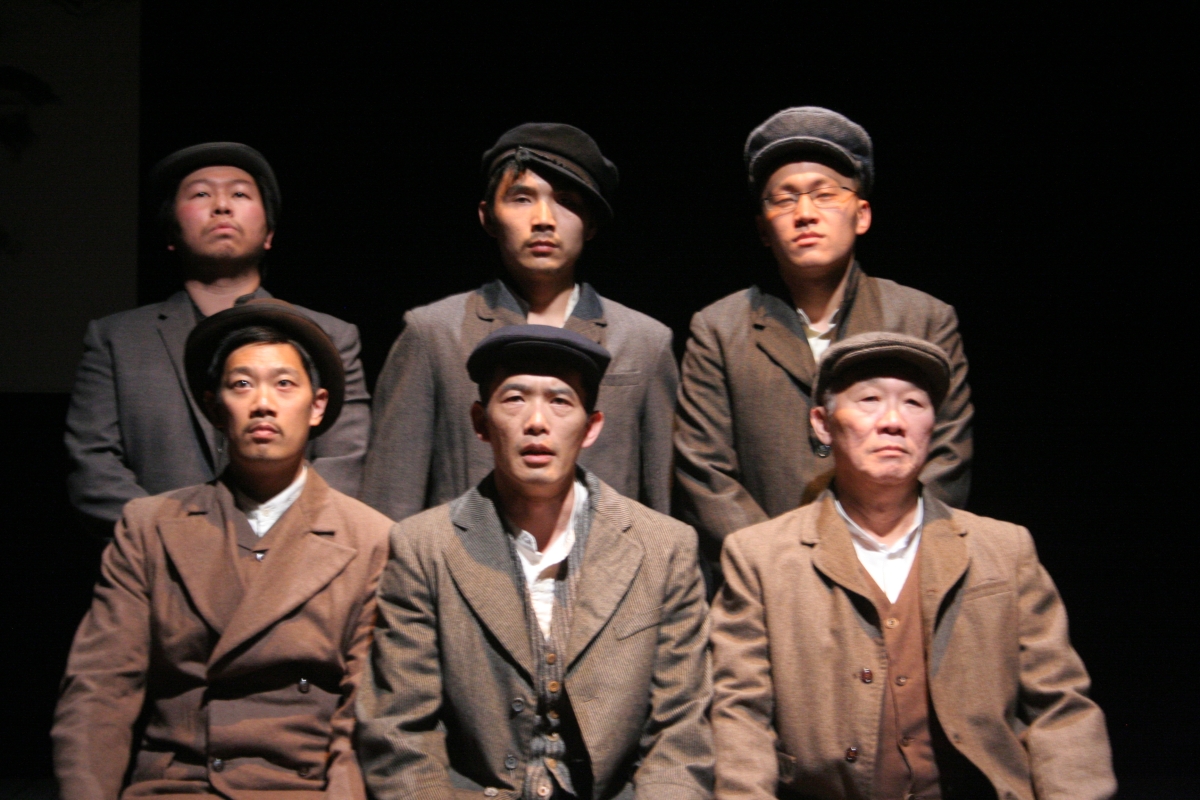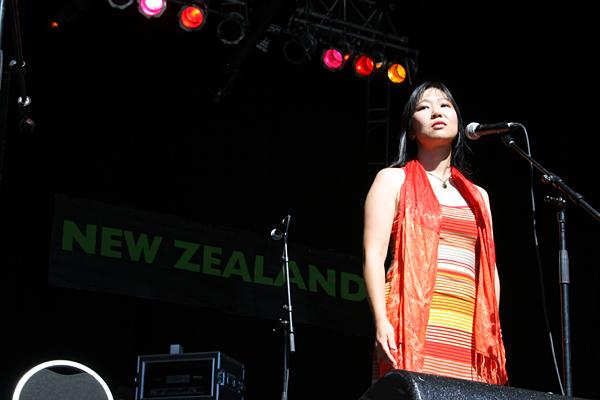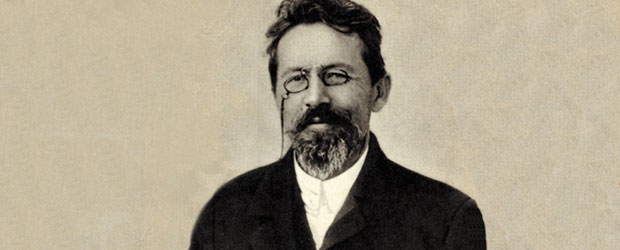Last month, I managed to catch up with poet, playwright, paediatrician and mother of two Renee Liang while she was in Wellington on locum at Hutt Hospital.
Juggling a baby, a chocolate cake and a multi-faceted career, we commenced.
Performing poetry at WOMAD. Image from The Big Idea.
Hey Renee! The Chinese name your Yeh Yeh (paternal grandfather) gave you was ‘Literary Blossom,’ as opposed to the regular old blossom. How did this discovery affect you?
My Yeh Yeh sourced a pretty rare character. Wei (blossom) is not an uncommon Chinese girls name, but there is an extra stroke on it to make it literary blossom. That with my generation Wen name made it wise/language literary blossom. I added it to my email signature in recent years, which I guess is part of my journey of being ‘more’ Chinese. A lot of my friends who are second or third generation Chinese have begun that journey in their late twenties, as many did not see the value of it when they were children while wanting to fit in.
Do you remember when you first started to write stories?
I wrote a lot when I was at secondary school, but then went on a journey to become a doctor. I remember being surprised the first time I was told I had a unique style – it was in primary school. I had a love of really long words which must have been a source of great amusement to my teachers. I had a phase where I needed to show off, so I’d open the dictionary and find the longest word I could, then deploy it into whatever I was writing about [laughs].
When I was about ten, we went to see The Neverending Story. I came out of the film complaining about the inaccuracies with the book and my dad saying ‘well fix it then, write the script.’ My aunty encouraged me to be a scriptwriter when I was a kid, which I thought was horrifying as I wanted to be the world’s greatest doctor! [laughs] Now, the irony is that I am writing scripts.
Writing doctors scripts and dramatic scripts!
I hadn’t actually thought about that, there is a good word play poem happening here!
When did you decide to pursue your writing alongside your career as a doctor?
Over time I realized I could have both. I wrote a poem called To A Husband on my last day of a full time job in clinical medicine before I started my Master of Creative Writing in Auckland, and it was based on a Chekhov quote – “Medicine is my lawful wife and literature my mistress; when I get tired of one, I spend the night with the other.”
The better I get at writing, the better I get at doctoring – its the same skill set. To use a metaphor, it’s to do with understanding what lies beneath.
When I place a drip in someone – I do it in very small children – I can feel my brain is in the tip of the needle when I insert it, and I can feel where I am in the skin. Its not spiritual, I can’t explain it, but its to do with experience. You know where to look and you know the signs. Poetry is the same.
How does your cultural background reach into your work as a writer?
Everybody writes informed by his or her cultural backgrounds. It’s a bit of a catch 22 as a writer or artist – you want to be a writer, you don’t want to just be the ‘Chinese writer’ or the writer who writes about cultural things.
I never asked to be a cultural ambassador. You can call it dumb luck or you can call it destiny. I started this writing career at exactly the right time. Publishers became quite interested, in the same way producers became interested in Roseanne’s work, because the publishers and producers who are knowledgeable in spotting trends before they emerge – the Maori Renaissance and strong Pacific writers – and that the next big thing, according to population statistics, was Asian writers.

The Bone Feeder looked at the sinking of the S.S Ventnor off Hokianga in 1902, a ship bound for China containing the bones of Chinese miners. Image from Theatre Scenes.
Do you then find it natural or obligatory to include Chinese themes in your work?
I argue that my plays are not about Chinese culture, but about family. I’ve also recently written a play called Boat People, in which I exploited the fact that I am known for writing cultural stories –it’s not about being Chinese at all, but in the public reading I asked for an all Asian cast to throw the audience off the scent. It’s a political thriller. I started writing it because I was so angry at what the Australian Government was doing with the refugee boat people.
I have also young teen play which was shortlisted for the Adam Award, but it will be harder to get that one performed because its not an ‘Asian’ play. If you have got a niche in this funding environment, then you probably have an advantage. Of course you need to stay true to yourself. Michelle Ang, who I interviewed for The Big Idea, was really frank about it too – you can be really cynical about it or say “hey, that’s life.”
What kind of productions can we expect to see on stage soon?
There are two plays I’ve just pitched. One is a Chinese folk tale adapted for children’s theatre for a non-Chinese theatre troupe called the Story of the Farting Sister.
The other is called Under the Same Moon, after a Tang Dynasty poem I really love, in which the final couplet is “though we live a thousand lengths apart, we all look on the same moon.” It’s a comedy about connection through the generations, based around a bolshy Hong Kong grandmother who invites herself to her granddaughter’s wedding.
Tell us about the New Kiwi Women Write Their Stories project in Auckland.
I was approached by Auckland Council two years ago too run some kind of cultural intervention in Albany. I suggested that we provide specific services for migrant women, who tend to be quite isolated but have a lot to think about and say. I didn’t want them to be migrant women writing about being migrants, I wanted them to write about anything from their hearts.
They are not classic migration stories. Their cultural viewpoint has been melded by both cultures.
The openness and attitude to telling a story has a very Kiwi style that has been overlaid over the top of the cultural memory.
A Chinese woman did the course twice, because she was so determined to crack the writing thing. She wrote a story called Fire Fire about her own memory of playing with matches as a kid and accidentally setting fire to the school, where the boys came along and hassled her trying to be like Red Guards.
An Iraqi woman wrote about being a university student and her classroom being bombed during the final exam. She wrote about leaving the classroom during the bomb alarm as usual, while continuing to think about what she would write in the exam.
Will Chinese stories in New Zealand ever just be stories without the cultural preface?
There has to be a cultural readiness to hear the stories. If you look at Asian American theatre, they have a parallel history to us in New Zealand. The plays Foh–Sarn and Ka-Shue by Lynda Chanwai-Earle about ten years ago reflect a very classic Chinese story. She was limited in what people were able to digest at the time, in what audiences would sign up for. My own play Lantern is gonna date over time, it’s little vignettes about racism. I hope it will date.
Do you have any advice for creative writers and poets who are starting out?
There are lots of senior people in their fields out there who are just waiting to be approached and love to meet young, enthusiastic writers who are prepared to back themselves and want to have a good old fashioned nerd out about writing. All you need to do is approach them or look them up in the phonebook. In New Zealand, you can do that.
Thanks, Renee!
Check out Renee’s blog Chinglish. You can also follow her on Twitter for more updates on her various projects and plays!
Article image is ‘Palace Ladies,’ wall painting, tomb of Princess Yongtai, Quinxian, China, Tang dynasty.




[…] Thanks to KAL! READ: Enter the Lounge with Kerry Ann LeeThanks, Renee! READ: The Literary Blossom: Renee Liang […]
LikeLike